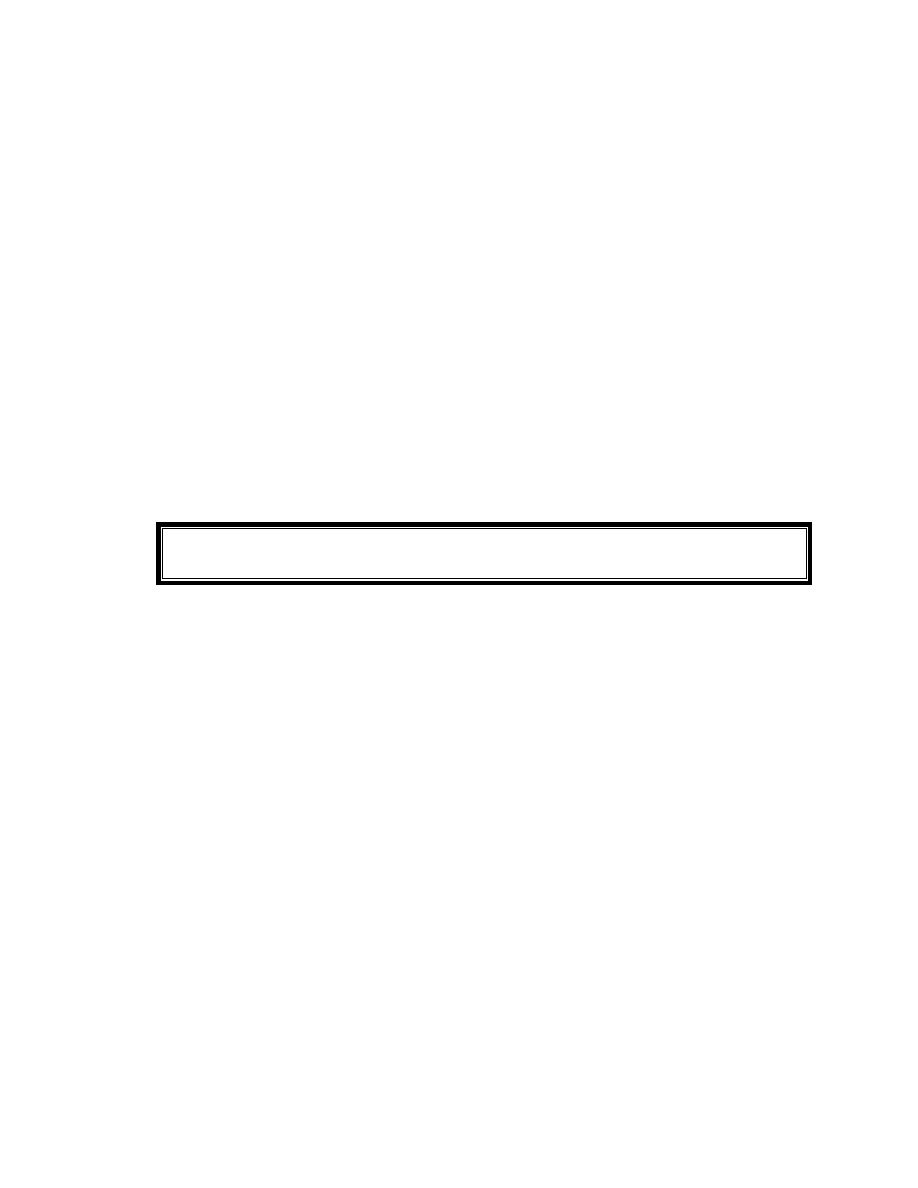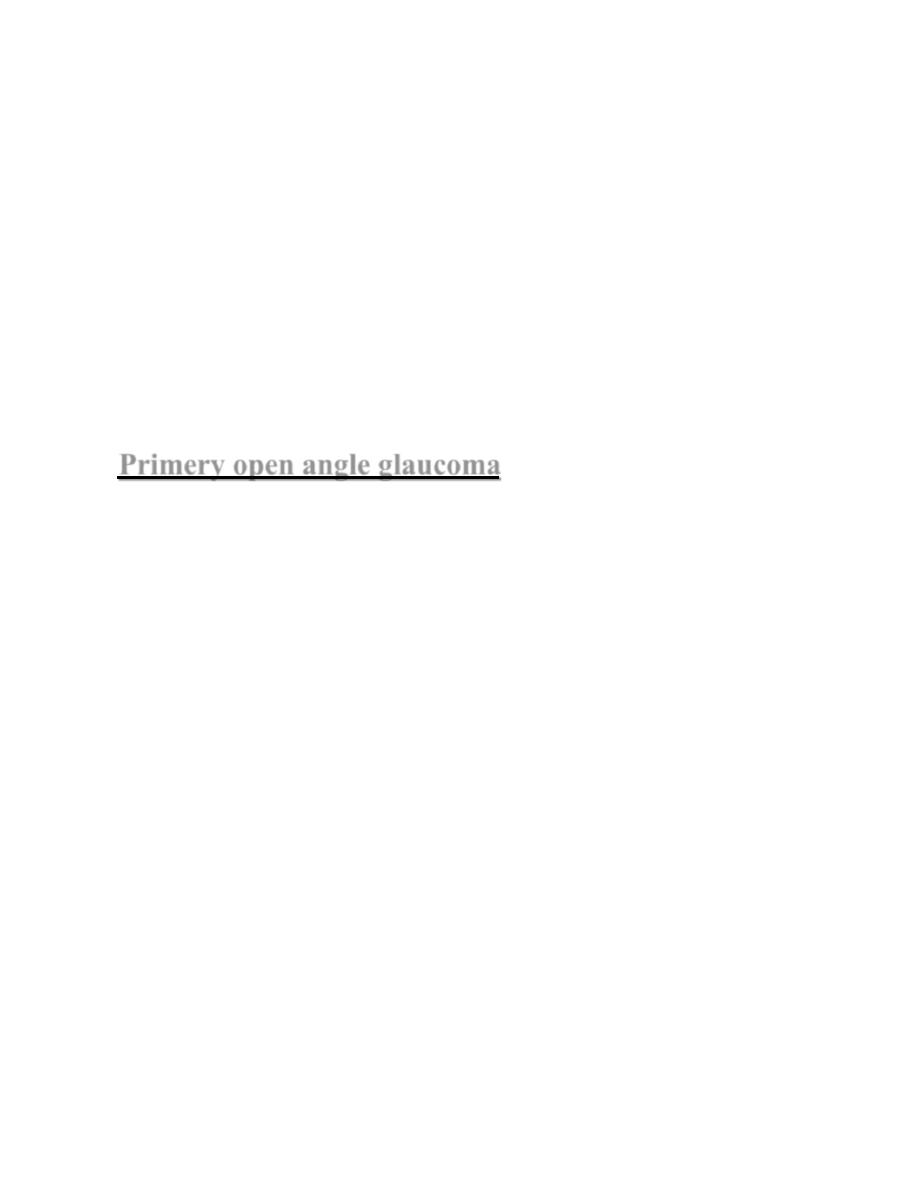
1
GLAUCOMA
Physiology of aqueous humour:
Aqueous humour: It is transparent intraocular fluid that fills the
anterior & posterior chamber, with very low protein content than the
plasma.
Function:
-Maintenance of the normal IOP.
-Nutrition to avascular structure (cornea & lens).
-One of the refractive media (RI=1.33).
Formation:
By non-pigmented epith. Of the ciliary body processes (pars plicata) 2
uL /min through
(1) Active secretion: By carbonic anhydrase enzyme & Na/K ATPase
pump. (60% of aqueous formation ).
(2) Ultra filtration: Due to difference in the hydrostatic pressure,
pressure inside the BVs>outside.
(3) Passive diffusion (through BVs walls): Osmotic pressure in
chambers & CB stroma > BVs.

2
INTRAOCULAR PRESSURE (IOP)
Normal IOP: It is the pressure under which the eye functions
normally.
Average IOP:
-Range between 10-21mm Hg.
-With normal difference between both eyes < 4mm Hg.
Diurnal variation:
It is highest in the morning & minimum in the evening due to:
(1) Ocular massage during the day increase drainage.
(2) Venous stagnation during sleeping decrease aq. Outflow.
(3) Circadian rhythm of steroids: steroid increase at the morning &
decrease at night.
Measurement of IOP:
(1) Digital palpation.
(2) Tonometry.
1. Indentation (Schiotz) tonometer.
2. Applanation tonometer (Goldman tonometry).
3. Perkins (hand held) tonometer.
4. Air puff tonometer.

3
GLAUCOMA
Definition: It is pathological elevation of IOP that leads to optic nerve
damage & visual filed defect.
Classification
1- Congenital.
2-Acquired: -Primary: 1) Closed angle CAG.
2) Open angle OAG.
- Secondary: 1) Closed angle.
2) Open angle.
Congenital Glaucoma (Buphthalmos) Ox-eye
Definition: It is increase IOP leading to optic n. damage due to
"congenital anomalies" closing the angle of the anterior chamber.
Symptoms & signs appear between birth &1st year.
Etiology:
(A) Primary Buphthalmos:
1- Abnormal mesodermal membrane close the angle of anterior
chamber "Barkan's membrane".
2- Forward insertion of iris to the trabecular meshwork.

4
3- Failure of complete separation of iris from the cornea.
4- Absence of schlemm's canal.
(B) 2ry Buphthalmos: Due to associated anomalies
or syndromes as:
1) Microphthalmos.
2) Ectopia lentis:
3) Phakomatosis:
a. Struge weber syndrome: Ipsilat. Hemangioma in skin
along distribution of 5th n., meninges & choroid.
b. Neurofibromatosis type I.
4) Retinoblastoma.
5) Birth trauma Neonatal iridocyclitis & hyphema.
6) Congenital Rubella, Lowe syndrome.
7) Iridocorneal dysgenesis:
-Axenfeld anomaly.
-Reiger anomaly.
- Aniridia: Absence of the iris with rudimentary stump that
occludes the angle.
Incidence:
1) Age: 80% of cases are presented before the age of 6 months.
2) Sex: More in boys 65 %.
3) Side: commonly bilateral.

5
Clinical picture:
- Symptoms: given by the mother.
1) Early: Lacrimation, photophobia, blepharospasm .
2) Late:
Large eye (buphthalmos or ox eye) due to elasticity of
outer coat.
Hazy cornea leads to defective vision.
-Signs:
The eye will distend with increase IOP as the outer coat is still elastic.
(1) Cornea:
Diameter: increase 12-16 mm.
Curvature: decrease (more flat).
Transparency: decrease (Hazy & oedematous).
Haab’s striae (horizontal lines)
(2) Sclera: blue (being thin, showing the underlying choroid)
(3) AC: Deep as the lens becomes flat & displaced backwards.
(4) IOP: High.
(5) Fundus: cupping & atrophy of the optic disc occur Late.
(6) Gonioscopy : Abnormalities of the angle.
Diagnosis:
1) Measurement of corneal diameter.
2) Gonioscopy.
3) Measurement of IOP.

6
Differential diagnosis: from other causes of:
(1)Corneal enlargement in:
Megalocornea & Congenital myopia: No signs of buphthalmos.
(2) Corneal clouding: As
-Keratitis from intrauterine infection.
-Traumatic corneal oedema .
-Metabolic disorder: mucopolysacharidosis
-Corneal dystrophies.
-Cornea planna.
(4) Watering of the eye in child:
-Buphthalmos.
-Congenital nasolacrimal duct obstruction
-Viral conjunctivitis (ophthalmia neonatorum)
-Corneal abrasion.
Treatment:
Mainly surgical.
The early interference the better the prognosis.
(A)Medical: to decrease IOP as preoperative preparation & after
operation.
1- Systemic CAI e.g. Acetazolamide (Diamox).
2- Topical CAI e.g. Dorzolamide.
3- Beta blocker (Timolol 0.25% twice daily).

7
(B) Surgical:
(1) Early cases: Corneal diameter < 13mm.
Canal of Schlemm is present.
i)
Clear cornea
Goniotomy.
ii)
Hazy cornea
Trabeculotomy.
(2)Late cases: Corneal diameter ≥13 mm.
Schlemm's canal abscent or fibrosed.
Trabeculectomy
Closed angle glaucoma =Acute congestive glaucoma
Definition: It is acute increase of IOP due to sudden closure of a
narrow angle by the iris, occurs in attacks.
Incidence:
-Bilateral (one eye before the other).
-More common in females.
- > 40 years old.
Etiology:
Predisposing factors:
Narrow angle (commonly seen with shallow A.C.) as in:
1- Hypermetropes (small eyes).

8
2-Old age (due to progressive increase in lens thickness which
pushes the iris forward).
3-Menopausal females: due to hormonal changes congestion of
CB which push the iris forward).
Clinical picture (Stages):
(1) Latent (asymptomatic) stage:
-By slit lamp: Shallow AC& the periphery of the iris close to the
cornea.
-Treatment: Prophylactic laser peripheral iridotomy to decrease
the risk of ACG.
(2)(Intermittent = Subacute) Prodromal stage:
* Characterized by transient mild attacks of increase IOP
* Transient attacks of:
-Headache (pressure on the coat).
-Blurred vision (hazy cornea).
-Colored haloes around light.
*Signs: 1) No or mild congestion.
2) Pupil: Slightly dilated, sluggish reaction.
3) IOP: Moderately elevated (30mm).

9
* Diagnosis:
Normal IOP (in between attack) & diagnosis depends on:
a) History: transient attacks after prolonged stay in the dark or
excitement.
b) Gonioscopy: Revealed narrow angle.
c) Provocative tests:
(3) Acute (congestive) stage:
*Symptoms:
1- Headche & Ocular pain.
2-Diminution of vision (Rapid & marked) hand movement or
perception of Light:
Due to a) Corneal & lens oedema.
b) Optic n. ischemia by mechanical pressure.
3) Lacrimation, photophobia, blepharospasm & colored haloes
around light due to corneal oedema.
Medical treatment
(1) Topical treatment
1) Miotics:
-Examples: pilocarpine nitrate 2-4% drops
-Administration: Every 5 min, till the pupil constricts,
then every 2-3 hours for 24 hours until the operation.

10
-Disadvantages: not act if the IOP > 40 mm.
-Action:
1-Contraction of sphincter pupillae muscle leads to
Pulls the iris away from the angle.
2-Widens the iris crypts increase drainage.
2) Other topical drugs:
1- Topical B-blockers: e.g. timolol maleate 0.25% - 0.5% .
2- Topical CAIs e.g. dorzolamide.
3- Alpha-2 agonist:
e.g. apraclonidine
4- Topical steroids: decrease peripheral anterior synechia
& iritis.
(2)General treatment
1) Analgesics & Antiemetics e.g. NSAID or morphine.
2) Carbonic Anhydrase inhibitors (CAI) e.g. Acetazolamide.
Surgical treatment
(1)Peripheral iridectomy:
-Principle: Communication between post. & ant. chamber, so
prevent future closure of angle.
-Indications: (i) Prodromal stage.
(ii) Acute stage with no PAS.

11
(iii) Prophylactic treatment in the other eye.
IT is done either by:
(i) Surgery.
(ii) Laser iridotomy
(2) External fistulizing operation: e.g. trabeculectomy
-Indications: (i) Acute stage
(ii) Chronic stage.
Primery open angle glaucoma
*Definition: Bilateral, Asymmetrical, non- congestive increase of
IOP in absence of angle closure Leading to optic nerve damage &
visual field defect.
*Incidence:
*Age: above 50 years.
*Sex: Equal.
*Bilateral: But one eye precedes the other.
*Risk factors:
*Positive family history.
*Race: More common in black.
*Ocular diseases: myopia &CRVO.
*Systemic diseases: DM, vasospastic disorder, migraine.
*Ocular hypertension.

12
Signs:
1- Increase IOP.
2- Glaucoma Cupping.
3- Field defects.
4- Gonioscopy OPEN ANGLE
*Normal cup / disc ratio (C/D) is 0.3 or less.
The cause of glaucomatous cupping may be:
(1)Mechanical theory: increase IOP Backward bowing of lamina
cribrosa, as it's the weakest part of sclera + Compression &
degeneration of optic nerve fibers.
(2)Ischemic (Vascular) theory: Sclerosis of vessels
Visual Field changes
Cause: due to optic nerve fibers damage caused by ischemia &
mechanical pressure (field defect appears if 40% of optic nerve fibers
are lost).
1. Early changes: include increased variability of responses in areas
that subsequently develop defects, and slight asymmetry between
the two eyes.
2. paracentral scotoma: can form at a relatively early stage, often
superior-nasally.

13
3. Nasal step: represents a difference in sensitivity above and below
the horizontal midline in the nasal field.
4. Temporal wedge: is less common than a nasal step but has similar
implications.
5. Arcuate defects: develop as a result of coalescence of paracentral
scotomas. They typically develop downward or upward extensions
from the blind spot (‘baring of the blind spot’ around fixation. With
time, they tend to elongate circumferentially along the distribution
of arcuate nerve fibers.
6. A ring scotoma: develops when superior and inferior arcuate
defects become continuous, usually in advanced glaucoma.
7. End-stage changes: are characterized by a small island of central
vision, typically accompanied by a temporal island.
*Testing with perimetry:
Kinetic: presentation of a moving stimulus of fixed size &Intensity
from non-seeing area until it is perceived
Static: It is involves presentation of non-moving stimuli of varying
intensity in the same position.
Treatment
1. Medical.

14
2. Laser trabeculoplasty.
3. Surgical (Trabeculectomy).
(A)Medical treatment
Topical treatment:
1) B-Blockers:
-Examples: *Timolol maleate 0.25-0.5%
*Betaxolol HCI (Betoptic).
-Administration: Every 12 hours.
-Action: decrease aqueous formation (Block B receptors on
ciliary body epith.).
2) Prostaglandin Analogues:
-Example: as *Latanoprost (xalatan 0.005%).
*Travoprost ( Travatan).
-Action: increase uveoscleral out flow.
-Administration: once at night
3) Topical CAIS:
-Example: Dorzolamide (Trusopt 2%).
-Administration: 2 times / day.
4) Alpha-2 agonist:
-Example: adrenaline 1-2 %, Brimonidine, apraclonidine
-Action: Alpha-2 agonists decrease IOP by both decreasing
aqueous secretion and enhancing uveoscleral outflow.

15
5) Miotics:
-Example: pilocarpine 1-4% drops
- Action: increase the trabecular out flow.
(B) Laser Trabeculoplasty
*Indications:
1-With medical treatment: ( to avoid poly pharmacy).
2- Especially with pigmentary glaucoma.
Types:
a) Argon Laser Trabeculoplasty (ALT): uses laser burns to achieve
IOP reduction.
b) Selective Laser Trabeculoplasty (SLT): uses Nd:YAG laser to
selectively target melanin pigment in trabecular meshwork
(C) Surgical treatment:
External fistulizing operations:
(1)
trabeculectomy
(2)
Drainage Shunts using episcleral explants
*Indication: if
(1) Medical treatment fails to control IOP.
(2) Significant side effect of medical treatment.
(3) Deterioration of field.
(4) The patient is poor.
(5) Young patient.

16
SECONDARY GLAUCOMA
Definition: it is increase of IOP secondary to local or systemic disease.
Etiology:
(A) Systematic causes: It is results from rise of pressure in the
episcleral veins
(B) Local Diseases: e.g. in
(1) Cornea
(2) Ant. Chamber.
(3) Uveitis, iritis
A-OPEN ANGLE
1- phacolytic glaucoma.
2- Traumatic cataract
B-CLOSE ANGLE
1) Phacomorphic glaucoma.
2) Anterior dislocation.
3) Posterior dislocation or subluxation
4) Micro – spherophakia.
*Trauma causes glaucoma:
Due to (1) Hyphaema.
(2) Traumatic iritis.
(3) Angle recession glaucoma.
